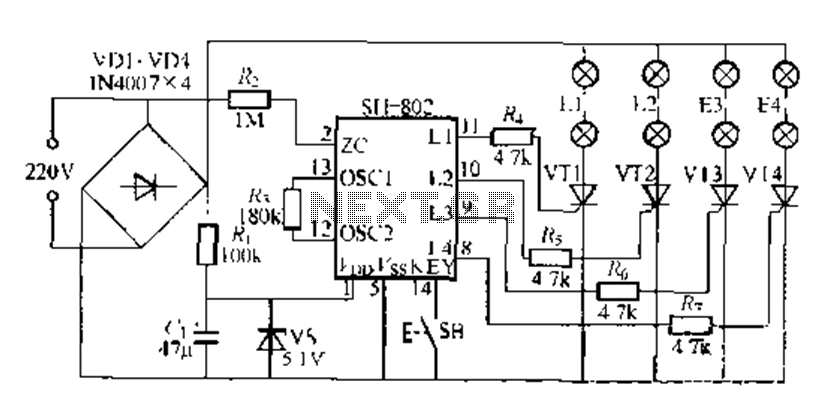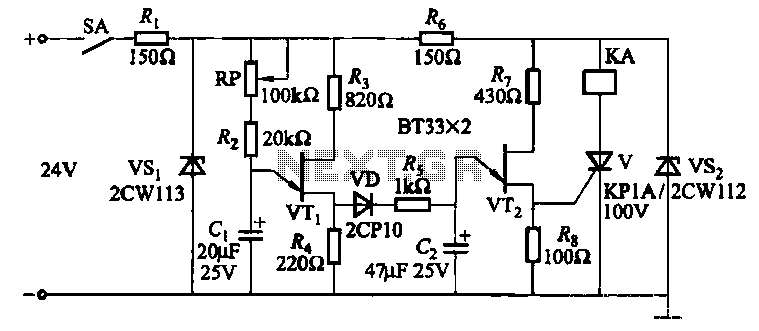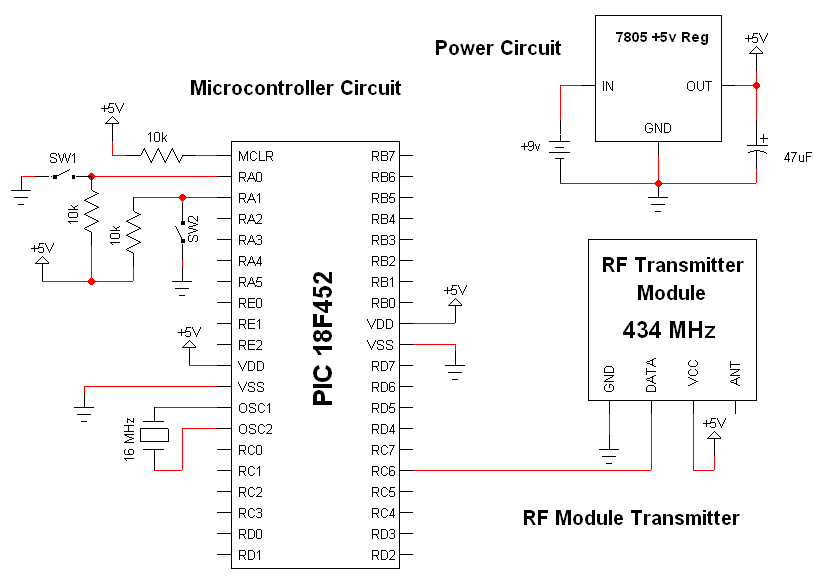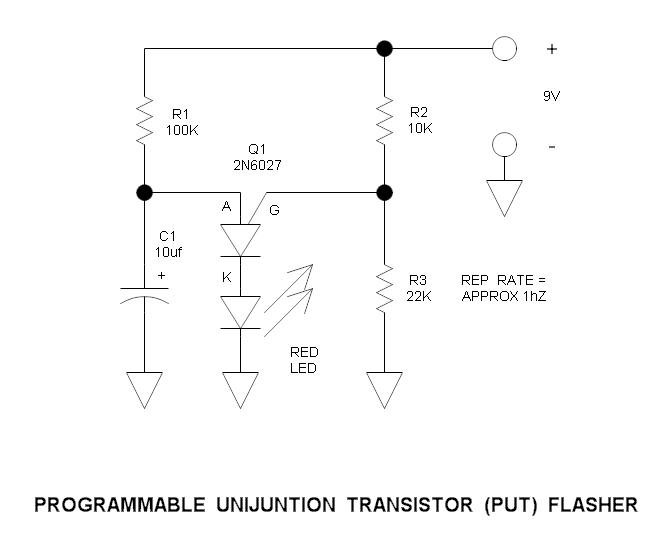
A motor reversing automatic adjustment circuit
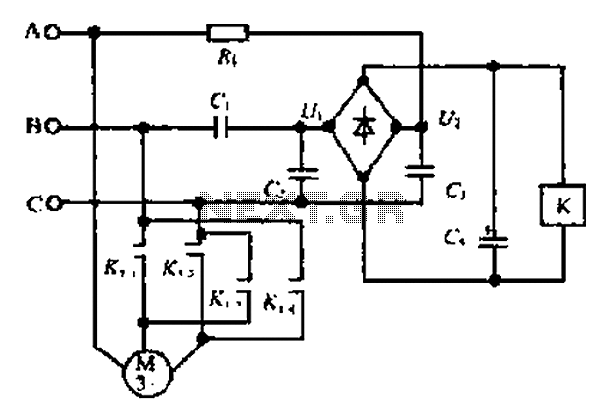
Composition ratio circuit. The circuit consists of resistors and capacitors that form a shift register circuit with diodes VD1 to VD4, creating a bridge for electric current. Capacitor C4 is utilized for filtering applications and for eliminating instantaneous relay energization during the operation. When the phases are A-B-C (with B and C phases lagging and the A phase leading), the voltage Uc advances in relation to UBc. When the circuit is viewed from the scaling perspective, Ui equals J/2Us, where Um represents the amplitude of the three-phase voltage. From the phase shift circuit involving resistors and capacitor C3, the amplitude of voltage U2 can be calculated as (Um/Z)/(Cp). Simplifying further, U1 is derived. When Ic equals 3, the relationship yields U2 equal to 2Um, resulting in Ui being equal to 2Um. The output point allows current to flow through the relay, activating the motor in an ABC sequence. If the wiring is altered for AC at phase B, the amplitudes may not be equal, potentially causing erratic behavior in motor rotation.
The composition ratio circuit is designed to manage the phase relationships between multiple voltage sources, ensuring proper operation of devices such as motors and relays. The circuit employs a combination of resistors (Ri, R) and capacitors (C, C3, C4) to establish a controlled phase shift. Diodes VD1 to VD4 create a bridge configuration, allowing for efficient current flow while protecting against reverse polarity and ensuring that the operation remains stable under varying load conditions.
Capacitor C4 plays a critical role in filtering out noise and stabilizing the voltage output, which is essential during relay activation. This filtering capability prevents false triggering of the relay, ensuring that the motor operates only when the conditions are suitable. The relationship between the phases is crucial for maintaining the correct sequence of operation; thus, the circuit's design allows for adjustments based on load and phase requirements.
The scaling circuit provides a means to monitor and adjust the voltage levels, where Ui is derived from the three-phase voltage amplitude Um. The calculated voltage U2, based on the impedance Z and capacitance Cp, allows for precise control over the circuit's response to changes in load or supply conditions. The output configuration is designed to facilitate the flow of current through the relay, which subsequently energizes the motor in a predefined sequence (A, B, C).
In the event of a phase alteration, such as switching the wiring for AC at phase B, the circuit's design must account for potential discrepancies in amplitude. This situation could lead to erratic motor behavior, emphasizing the importance of maintaining balanced phase relationships for optimal performance. Overall, this circuit is integral in applications where precise control of motor operation is required, particularly in industrial settings where reliability and efficiency are paramount. C ,. C! Composition ratio circuit. Ri. C, constituting the shift shed circuit diode VDi - VD4 constitute destroy stream bridge, electric pit C4 is used - Application Filtering and elimination of instant relay is energized Mau spy operation. When the phase FF is A - B - C (B .C phase phase phase lag rA rB phase advance) when, U c advance UBc. When cl c-, when seen from the scaling circuit. Ui J/2U s, where Um is the three-phase voltage amplitude. From the phase shift circuit r Ri, c3 constituted, T calculated U2 fYJ voltage amplitude of U! Two (Um/Z)/( C p). To simplify too ! Uln October. :(. 3.j. When I icl 3, the la u2 1 2um, namely ui l zi 2um. and feng bian h bit with, open i) point output hip as i n, current flows through relay 0, kl water moves electrical motor cap sequence is abc.
when wiring to change phase for ac at b .u {.ul, amplitude are not equal, blind trust, chu action, loving rotation of constant.
The composition ratio circuit is designed to manage the phase relationships between multiple voltage sources, ensuring proper operation of devices such as motors and relays. The circuit employs a combination of resistors (Ri, R) and capacitors (C, C3, C4) to establish a controlled phase shift. Diodes VD1 to VD4 create a bridge configuration, allowing for efficient current flow while protecting against reverse polarity and ensuring that the operation remains stable under varying load conditions.
Capacitor C4 plays a critical role in filtering out noise and stabilizing the voltage output, which is essential during relay activation. This filtering capability prevents false triggering of the relay, ensuring that the motor operates only when the conditions are suitable. The relationship between the phases is crucial for maintaining the correct sequence of operation; thus, the circuit's design allows for adjustments based on load and phase requirements.
The scaling circuit provides a means to monitor and adjust the voltage levels, where Ui is derived from the three-phase voltage amplitude Um. The calculated voltage U2, based on the impedance Z and capacitance Cp, allows for precise control over the circuit's response to changes in load or supply conditions. The output configuration is designed to facilitate the flow of current through the relay, which subsequently energizes the motor in a predefined sequence (A, B, C).
In the event of a phase alteration, such as switching the wiring for AC at phase B, the circuit's design must account for potential discrepancies in amplitude. This situation could lead to erratic motor behavior, emphasizing the importance of maintaining balanced phase relationships for optimal performance. Overall, this circuit is integral in applications where precise control of motor operation is required, particularly in industrial settings where reliability and efficiency are paramount. C ,. C! Composition ratio circuit. Ri. C, constituting the shift shed circuit diode VDi - VD4 constitute destroy stream bridge, electric pit C4 is used - Application Filtering and elimination of instant relay is energized Mau spy operation. When the phase FF is A - B - C (B .C phase phase phase lag rA rB phase advance) when, U c advance UBc. When cl c-, when seen from the scaling circuit. Ui J/2U s, where Um is the three-phase voltage amplitude. From the phase shift circuit r Ri, c3 constituted, T calculated U2 fYJ voltage amplitude of U! Two (Um/Z)/( C p). To simplify too ! Uln October. :(. 3.j. When I icl 3, the la u2 1 2um, namely ui l zi 2um. and feng bian h bit with, open i) point output hip as i n, current flows through relay 0, kl water moves electrical motor cap sequence is abc.
when wiring to change phase for ac at b .u {.ul, amplitude are not equal, blind trust, chu action, loving rotation of constant.

